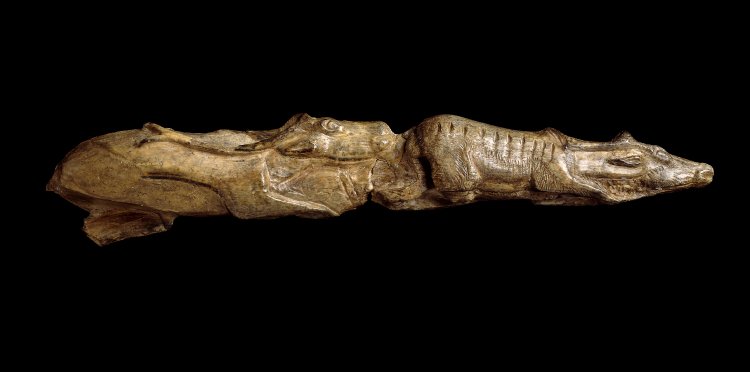
The swimming reindeer by unknown artist, c. 11,000 BCE. The British Museum (Photo: © Trustees of the British Museum).
These swimming reindeer are one of the most famous prehistoric artworks in the world – and they were made by a girl.
One autumn during the last Ice Age, an artist sat watching reindeer. They were beautiful this time of year – with both males and females having antlers as they rutted and roamed in herds across the open, treeless plains of Europe. Carved from the tip of a mammoth tusk, the leading figure of this object is a female, with a smaller body and antlers, whose fine notchings suggest her coat had many colors. The other is a male, with large antlers but no shading in its coat. Both have their chins up, antlers back, and legs extended as if they are swimming. They were made 13,000 years ago and left in a rock shelter in Montastruc, France.
The artist was highly skilled and knew reindeer intimately, having observed them in close detail and the wild. Analysis of the object shows it was made with four different techniques: chopping, whittling, polishing, and carefully incising the details. It would take a great deal of time with reindeer to be able to carve something so intimate. Time that only a woman might have had.
Analysis of hand prints in prehistoric art has revealed that three-quarters were made by women. New evidence about Ice Age societies also shows that humans survived largely because of women’s work – both in gathering plants and communal hunting to take down large predators. Additionally, new evidence on the Venus figurines – which were being made around or before the time of the Swimming Reindeer – suggests they were also made by women. This evidence is supported by oral histories and historical accounts of modern hunter-gatherers.
I love this object because it shows that women knew reindeer intimately – observing behavior on the hunt and the fine details while processing a kill. The artist of the Swimming Reindeer had done both, and crafted a mammoth tusk into a memory of deer in autumn. Perhaps she used it in rituals or it might have been a gift for herself or her lover. To me, it feels like a gift – carving a scene she loved, where the male and female are so alike. It’s like a reminder of a partnership – both parties different, but equal, and swimming the tides of life together.
Whatever its use, the Swimming Reindeer took time and skill to craft. And the evidence points to the skill being that of a woman or young girl, whose memory we found 13,000 years after the sight of reindeer in autumn.
– Tiffany Rhoades
Program Developer
Girl Museum, Inc.
This post is part of our 52 Objects in the History of Girlhood exhibition. Each week during 2017, we explore a historical object and its relation to girls history. Stay tuned to discover the incredible history of girls, and be sure to visit the complete exhibition to discover the integral role girls have played since the dawn of time.
For more on the Swimming Reindeer, check out BBC’s A History of the World #4 podcast.
